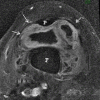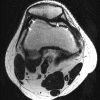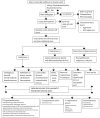Intra-articular and Peri-articular Tumours and Tumour Mimics- What a Clinician and Onco-imaging Radiologist Should Know
- PMID: 24876802
- PMCID: PMC4028566
Intra-articular and Peri-articular Tumours and Tumour Mimics- What a Clinician and Onco-imaging Radiologist Should Know
Abstract
Definitive determination of the cause of articular swelling may be difficult based on just the clinical symptoms, physical examinations and laboratory tests. Joint disorders fall under the realms of rheumatology and general orthopaedics; however, patients with joint conditions manifesting primarily as intra-articular and peri-articular soft tissue swelling may at times be referred to an orthopaedic oncology department with suspicion of a tumour. In such a situation, an onco-radiologist needs to think beyond the usual neoplastic lesions and consider the diagnoses of various non-neoplastic arthritic conditions that may be clinically masquerading as masses. Differential diagnoses of articular lesions include infectious and non-infectious synovial proliferative processes, degenerative lesions, deposition diseases, vascular malformations, benign and malignant neoplasms and additional miscellaneous conditions. Many of these diseases have specific imaging findings. Knowledge of these radiological characteristics in an appropriate clinical context will allow for a more confident diagnosis.
Keywords: intra-articular; peri-articular; synovial; tumours.
Figures


















Similar articles
-
Para-articular and intra-articular soft tissue lesions: Radiologic-pathologic correlation.Eur J Radiol. 2024 Dec;181:111718. doi: 10.1016/j.ejrad.2024.111718. Epub 2024 Sep 3. Eur J Radiol. 2024. PMID: 39357286 Review.
-
Imaging of intraarticular masses.Radiographics. 2005 Jan-Feb;25(1):105-19. doi: 10.1148/rg.251045050. Radiographics. 2005. PMID: 15653590 Review.
-
Characterisation of intra-articular soft tissue tumours and tumour-like lesions.Eur Radiol. 2007 Apr;17(4):950-8. doi: 10.1007/s00330-006-0381-4. Epub 2006 Aug 29. Eur Radiol. 2007. PMID: 16941090
-
Suspected intra-articular soft-tissue tumours and tumour-like lesions: Performance of image-guided core needle biopsy.Eur J Radiol. 2021 Feb;135:109469. doi: 10.1016/j.ejrad.2020.109469. Epub 2020 Dec 5. Eur J Radiol. 2021. PMID: 33348281
-
Diagnostic Imaging and Management of Common Intra-articular and Peri-articular Soft Tissue Tumors and Tumorlike Conditions of the Knee.J Knee Surg. 2019 Apr;32(4):322-330. doi: 10.1055/s-0038-1675609. Epub 2018 Nov 16. J Knee Surg. 2019. PMID: 30449023 Free PMC article. Review.
Cited by
-
Antiarthritic Activity of Achyranthes Aspera on Formaldehyde - Induced Arthritis in Rats.Open Access Maced J Med Sci. 2019 Aug 30;7(17):2709-2714. doi: 10.3889/oamjms.2019.559. eCollection 2019 Sep 15. Open Access Maced J Med Sci. 2019. PMID: 31844425 Free PMC article.
-
Pediatric solid intra-articular masses of the knee: prevalence, imaging features and etiologies.Pediatr Radiol. 2021 Jul;51(8):1412-1420. doi: 10.1007/s00247-021-04993-1. Epub 2021 Apr 9. Pediatr Radiol. 2021. PMID: 33835215
-
Synovial metastasis of the knee in a KRAS mutant rectal adenocarcinoma patient.BMJ Case Rep. 2017 Aug 7;2017:bcr2017220008. doi: 10.1136/bcr-2017-220008. BMJ Case Rep. 2017. PMID: 28784880 Free PMC article. Review.
-
Index case of synovial metastasis in a patient with transitional cell carcinoma of the bladder.BMJ Case Rep. 2020 Jun 28;13(6):e235084. doi: 10.1136/bcr-2020-235084. BMJ Case Rep. 2020. PMID: 32595116 Free PMC article. Review.
References
-
- Llauger J, Palmer J, Rosón N, Bagué S, Camins A, Cremades R. Nonseptic Monoarthritis: Imaging Features with Clinical and Histopathologic Correlation. Radiographics. 2000;20:S263–S278. - PubMed
-
- Sheldon PJ, Forrester DM, Learch TJ. Imaging of Intraarticular Masses. Radiographics. 2005;25(1):105–119. - PubMed
-
- Bredella MA, Stoller DW, Johnston JO. Magnetic Resonance Imaging in Orthopedics and sports medicine. In: Stoller DW, editor. Bone and Soft tissue tumors. 3rd ed. Philadelphia (US): Lippincott Williams & Wilkins; 2007. pp. 2045–2161.
-
- Lee FY, Keel SB, Gebhardt MC, Rosenthal DI. Intraarticular lipoma with osteochondroid metaplasia in the knee joint. Skeletal Radiol. 2001;30(4):230–233. - PubMed
-
- Marui T, Yamamoto T, Kimura T, Akisue T, Nagira K, Nakatani T, et al. A true intra-articular lipoma of the knee in a girl. Arthroscopy. 2002;18(5):E24. - PubMed
LinkOut - more resources
Full Text Sources
